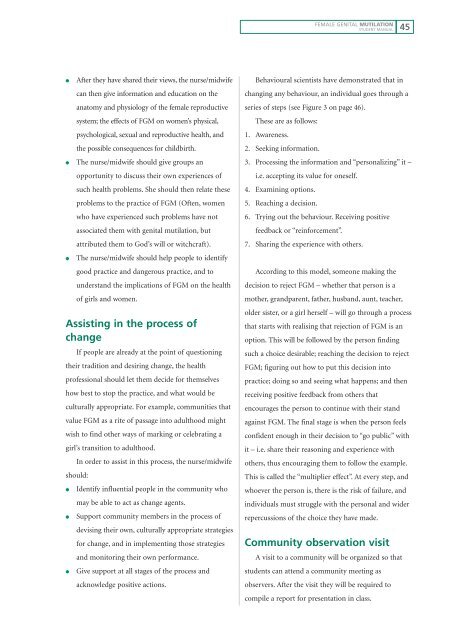Female Genital Mutilation - World Health Organization
Female Genital Mutilation - World Health Organization
Female Genital Mutilation - World Health Organization
You also want an ePaper? Increase the reach of your titles
YUMPU automatically turns print PDFs into web optimized ePapers that Google loves.
● After they have shared their views, the nurse/midwife<br />
can then give information and education on the<br />
anatomy and physiology of the female reproductive<br />
system; the effects of FGM on women’s physical,<br />
psychological, sexual and reproductive health, and<br />
the possible consequences for childbirth.<br />
● The nurse/midwife should give groups an<br />
opportunity to discuss their own experiences of<br />
such health problems. She should then relate these<br />
problems to the practice of FGM (Often, women<br />
who have experienced such problems have not<br />
associated them with genital mutilation, but<br />
attributed them to God’s will or witchcraft).<br />
● The nurse/midwife should help people to identify<br />
good practice and dangerous practice, and to<br />
understand the implications of FGM on the health<br />
of girls and women.<br />
Assisting in the process of<br />
change<br />
If people are already at the point of questioning<br />
their tradition and desiring change, the health<br />
professional should let them decide for themselves<br />
how best to stop the practice, and what would be<br />
culturally appropriate. For example, communities that<br />
value FGM as a rite of passage into adulthood might<br />
wish to find other ways of marking or celebrating a<br />
girl’s transition to adulthood.<br />
In order to assist in this process, the nurse/midwife<br />
should:<br />
● Identify influential people in the community who<br />
may be able to act as change agents.<br />
● Support community members in the process of<br />
devising their own, culturally appropriate strategies<br />
for change, and in implementing those strategies<br />
and monitoring their own performance.<br />
● Give support at all stages of the process and<br />
acknowledge positive actions.<br />
FEMALE GENITAL MUTILATION<br />
STUDENT MANUAL<br />
Behavioural scientists have demonstrated that in<br />
changing any behaviour, an individual goes through a<br />
series of steps (see Figure 3 on page 46).<br />
These are as follows:<br />
1. Awareness.<br />
2. Seeking information.<br />
3. Processing the information and “personalizing” it –<br />
i.e. accepting its value for oneself.<br />
4. Examining options.<br />
5. Reaching a decision.<br />
6. Trying out the behaviour. Receiving positive<br />
feedback or “reinforcement”.<br />
7. Sharing the experience with others.<br />
According to this model, someone making the<br />
decision to reject FGM – whether that person is a<br />
mother, grandparent, father, husband, aunt, teacher,<br />
older sister, or a girl herself – will go through a process<br />
that starts with realising that rejection of FGM is an<br />
option. This will be followed by the person finding<br />
such a choice desirable; reaching the decision to reject<br />
FGM; figuring out how to put this decision into<br />
practice; doing so and seeing what happens; and then<br />
receiving positive feedback from others that<br />
encourages the person to continue with their stand<br />
against FGM. The final stage is when the person feels<br />
confident enough in their decision to “go public” with<br />
it – i.e. share their reasoning and experience with<br />
others, thus encouraging them to follow the example.<br />
This is called the “multiplier effect”. At every step, and<br />
whoever the person is, there is the risk of failure, and<br />
individuals must struggle with the personal and wider<br />
repercussions of the choice they have made.<br />
Community observation visit<br />
A visit to a community will be organized so that<br />
students can attend a community meeting as<br />
observers. After the visit they will be required to<br />
compile a report for presentation in class.<br />
45

















